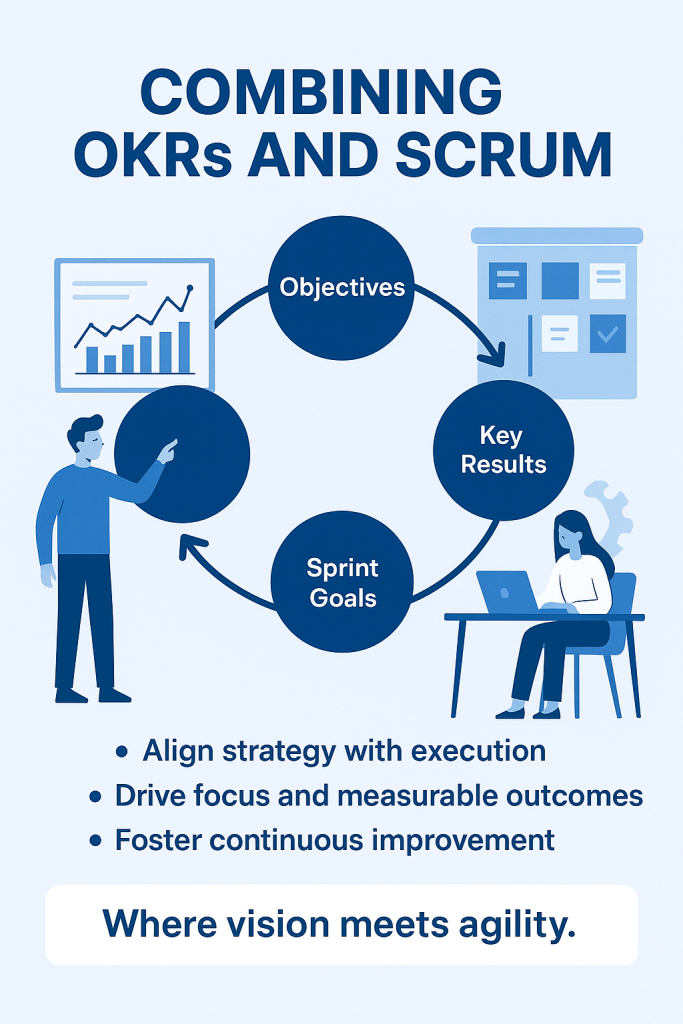In the modern workplace, where speed, adaptability, and clarity are everything, two frameworks have risen to the top — Scrum and OKRs (Objectives and Key Results).
Scrum helps teams deliver value quickly through iterative work and collaboration, while OKRs give that work direction and measurable purpose. When combined, they create a powerful synergy that drives real business outcomes, not just busy work.
It is no surprise that top organizations like Google, LinkedIn, Spotify, and Intel have adopted OKRs to set ambitious goals and use Agile frameworks like Scrum to execute them effectively. Together, they bridge the gap between strategy and delivery, ensuring teams stay focused on what truly matters.
Understanding OKRs and Scrum — The Basics
Before diving into how they work together, let’s clarify what each brings to the table.
OKRs (Objectives and Key Results) are a goal-setting framework that helps teams focus on outcomes rather than outputs.
Objectives define what you want to achieve, they are inspirational and directional.
Key Results define how you will measure success, they are specific and measurable.
Scrum, on the other hand, is an Agile framework that organizes work into Sprints, helping teams deliver increments of value regularly. It emphasizes collaboration, transparency, and continuous improvement all of which perfectly complement the OKR philosophy.
The challenge in most organizations is not that teams don’t work hard; it’s that they work on the wrong things.
By aligning OKRs with Scrum, you ensure that every sprint, every backlog item, and every stand-up contributes directly to business priorities.
How OKRs and Scrum Work Together
Let’s imagine your Scrum team is developing a new digital product.
Your company’s Objective might be:
“Improve customer engagement through a more personalized user experience.”
The Key Results could be:
Increase returning user sessions by 20%.
Reduce app churn rate by 10%.
Achieve a customer satisfaction score of 4.5+.
Each Sprint Goal the Scrum team defines can now tie directly to one or more Key Results. Suddenly, your backlog isn’t just a list of tasks, it is a roadmap to measurable success.
During Sprint Planning, teams can prioritize backlog items that contribute most to the OKRs. During Sprint Reviews, progress toward the Key Results can be evaluated alongside sprint outcomes. And during Retrospectives, the team can discuss not only how they worked, but whether their work moved the needle toward the desired business results.
This alignment transforms Scrum from a process framework into a strategy execution engine.
The Benefits of Combining OKRs and Scrum
The integration of OKRs and Scrum delivers several tangible benefits:
Clear Alignment Between Strategy and Execution
Every Scrum event, artifact, and decision is driven by strategic objectives — no wasted effort.
Greater Motivation and Ownership
Teams see the why behind their work, which increases engagement and accountability.
Focus on Value, Not Activity
OKRs help Scrum teams avoid the “busy trap.” Success isn’t measured by task completion but by meaningful results.
Improved Transparency Across the Organization
OKRs make priorities visible, while Scrum makes progress visible. Together, they create a shared understanding of success.
Adaptability and Agility
Both frameworks encourage iteration, learning, and continuous improvement crucial traits in today’s fast-changing business landscape.
In essence, OKRs ensure Scrum teams are rowing in the right direction, while Scrum ensures they’re rowing efficiently and effectively.
Practical Tips for Implementing OKRs with Scrum
If your organization wants to harness the synergy of these two frameworks, here are a few best practices:
Set OKRs at the Team Level: Let Scrum teams co-create their own OKRs aligned with company strategy. This fosters ownership and motivation.
Limit the Number of OKRs: Focus on 2–3 key objectives per quarter to maintain clarity and focus.
Review OKRs During Sprint Ceremonies: Integrate progress discussions into sprint reviews or retrospectives.
Use Data for Continuous Feedback: Leverage Agile metrics like velocity and cycle time alongside Key Results for better insights.
Empower Teams: Avoid micro-managing. Scrum thrives when teams self-organize and adapt — OKRs should guide, not dictate.
The secret lies not in rigidly enforcing two systems, but in blending their strengths to create clarity, focus, and alignment across teams.
Why Top Companies Are Doing It
Companies like Spotify, Atlassian, and Netflix have mastered this synergy by embedding OKRs within their Agile practices. For instance, Spotify uses OKRs to set outcomes at the squad level, while Scrum ceremonies ensure disciplined, transparent progress.
This combination has allowed them to scale agility, maintain innovation, and stay laser-focused on customer value — lessons that any modern business can learn from.
Final Thoughts
In a world where every organization is chasing agility and outcomes, the combination of OKRs and Scrum stands out as a proven, scalable way to align purpose with progress.
Scrum gives teams structure and rhythm. OKRs give them direction and impact.
Together, they create a culture where every sprint is strategic, and every deliverable moves the business closer to its vision.
Ready to take your skills to the next level?
Enroll today and transform your career with ScrumConsult’s professional training programs.
From Scrum Master Certification in Lagos to Agile Expert, Project Management, Business Analysis, Lean Six Sigma Green & Black Belt, SMC, PSM, and CSM, we provide the tools and knowledge you need to thrive in a results-driven world.
📌 Visit scrumconsult.com
today to get started.

